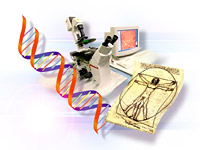| Anatomy |
|
||

Description Anatomy is the study of the structure of the human body. The study of anatomy can be divided into several separate but strongly related areas:
In all courses in Anatomy, strong emphasis is given to the functional significance of the structures in health and in disease.
Studying Anatomy at UNSW The Faculty of Science and the Faculty of Medicine at UNSW both offer undergraduate programs which involve the study of anatomy. Related postgraduate study is also available.
|
|||

| Contacts | Library | myUNSW | WebCT |